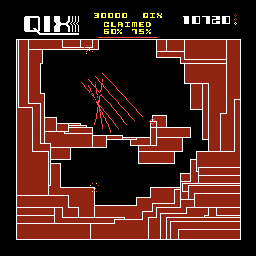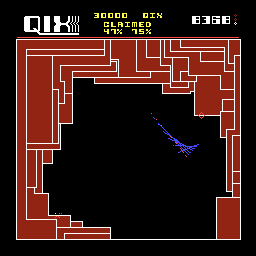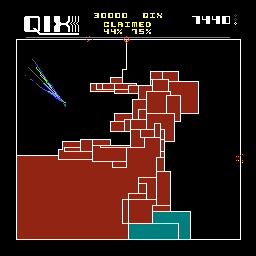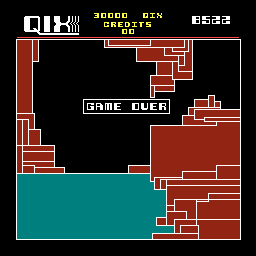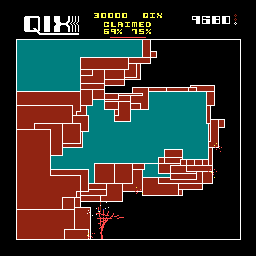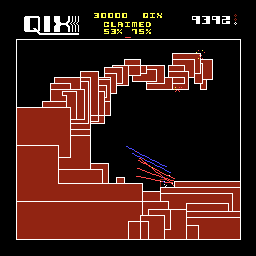Qix
In Qix the goal is to claim a percentage of the playfield by drawing lines that divide it. The player is vulnerable to contact in the act of drawing a new line—not just their avatar, but line they're currently drawing, too.
Qix is important because it makes visible the act of play: nearly each move made leaves a mark on the playfield. A game of Qix creates beautiful form through function. It fits very neatly into the idea of the act of play creating the narrative; but, by laying it all out in front of the player, Qix uses this unlike any other game I can think of.
Unfortunately this aspect of the game is somewhat ruined by the graphical additions of subsequent versions.
History
Qix was created in 1981 by Randy and Sandy Pfeiffer, and was the first game entirely produced by Taito America. It was, initially, popular in arcades, but enthusiasm dissipated when players learned the game was unbeatable and there is no singular play-pattern to learn/master.
Hardware
The Qix hardware was later used by 5 other games:
- Electric Yo-yo (1982)
- Kram (1982)
- Space Dungeon (1982)
- Qix II (1982)
- Zoo Keeper (1983)
Ports
Apart from the arcade version there are releases for the following platforms:
- Atari 5200
- Atari XEGS
- Acorn Electron (as Stix)
- BBC B (as Stix)
- Commodore64 (as Stix, and also as Qix)
- Atari 800
- Color Computer (as Qiks, and also as Quiks)
- Commodore Amiga
- Apple II
- IBM-PC (DOS)
- Apple IIGS
- NES / Famicom
- Game Boy
- Atari Lynx
- Nokia N-Gage
- Arcade Legends: Space Invaders TV Game
- Playstation 2 (within タイトーメモリーズⅡ 下巻 (Taito Memories 2 Gekan) & Taito Legends 2)
- XBox (within Taito Legends 2)
- PC (within Taito Legends 2)
See Also
- Let's Compare ( QIX ) - Youtube video.
Trivia
In High School David X Cohen created a Qix-alike called Zoid. He went on to use that name as the basis of a character in the Television series Futurama.1)
Qix cabinets appear in the films Joysticks, and The Karate Kid.

